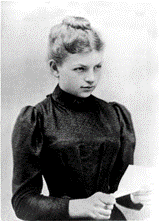Review
Clara Immerwahr was the first woman to obtain a doctorate in chemistry from the University of Breslau in 1900. She worked with her husband, Fritz Haber. He won the Nobel Prize for Chemistry in 1918. In 1904, they discovered the so-called Haber process for the synthesis of ammonia. This process revolutionised industry. Ammonia is used in the manufacture of fertilisers for crop production. He thanked his wife for her "silent collaboration" in the book "Thermodynamik technischer Gasreaktionen" (1905), in the introduction of which he acknowledged her having helped to develop the chemical weapons used in the First World War.
Justifications
- She worked with her husband, Fritz Haber (1864-1934), to synthesise ammonia to make fertiliser.
- The first woman to be awarded a doctorate in chemistry from the University of Wroclaw in 1900, she struggled to develop her scientific career because of her gender.
- Together with her husband Fritz Haber (1864-1934), she helped develop the chemical weapons used in World War I.
Biography
Immerwahr was born on a farm in Polkendorf, near Wroclaw (then East Prussia under the German-language name Breslau, now Polish-language Wrocław, in western Poland). She was the youngest daughter of Jewish parents, chemist Philipp Immerwahr and his wife Anna (née Krohn). In 1890, her mother died of cancer and Clara moved with her father to Wroclaw.
At that time women were not allowed to enter German universities so she decided to become a teacher and worked as a governess. In 1896, women were allowed to attend university classes as auditors. She became the first woman to pass the entrance exam and in 1900 she earned her doctorate at the University of Wroclaw, the first by a woman in this subject.
She began her scientific career as an assistant to her thesis director, in addition to publishing scientific articles and teaching at women's schools.
She married the also Jewish chemist Fritz Haber (1864-1934) in 1901. After the marriage, they moved to Karlsruhe, where Haber began working as a professor of chemistry. On June 1, 1902, she gave birth to their only son, Hermann. She contributed to her husband's work. In 1904 she discovered Haber's process for the synthesis of ammonia, which revolutionized the economy. Ammonia is used in the manufacture of fertilizers for crop production. He thanked his wife for her "silent cooperation" in the book Thermodynamik technischer Gasreaktionen (1905).
During World War I, Fritz Haber played an important role in the development of chemical weapons (especially poison gases). His efforts culminated in the first gas attack in military history at the Second Battle of Ypres on April 22, 1915.
After Fritz Haber's return to Berlin, Clara shot herself in the chest with her husband's pistol. The circumstances of Clara's suicide have always remained obscure. It appeared in almost no newspapers and there is no evidence that an autopsy was performed. The undocumented nature of her death has generated much controversy, as well as the motives that drove her to commit such an act. It is thought that she was unhappy with her life and detested her husband's work on behalf of chemical weaponry.
A number of awards given out today bear her name. One referring to nuclear war prevention bears her name; another awarded by UniCat (Unifying Concepts in Catalysis) that aims to reward a young female scientist, in 2015 this award was achieved by the Spaniard Anna Company Casadevall.
https://mujeresconciencia.com/2019/02/28/clara-immerwahr-1870-1915-la-quimica-que-planto-cara-a-fritz-haber/ (accessed 12-2-2022)
Bibliography
Friedrich, Bretislav, Hoffmann, Dieter (2016). “Clara Haber, nee Immerwahr (1870–1915): life, work and legacy” Zeitschrift für anorganische und allgemeine Chemie, 642(6), pp. 437-448. (12-2-2022) <https://pure.mpg.de/pubman/faces/ViewItemFullPage.jsp?itemId=item_2615866_6>
Friedrich, Bretislav; Hoffmann, Dieter (2017). “Clara Immerwahr: A life in the shadow of Fritz Haber", en B. Friedrich, D. Hoffmann, J. Renn, F. Schmaltz, & M. Wolf (eds.). One Hundred Years of Chemical Warfare: Research, Deployment, Consequences. Gewerbestrasse: Springer Open, pp. 45-67. (10-12-2023)<https://library.oapen.org/handle/20.500.12657/27756>
Johnson, Jeffrey (1998). “German women in chemistry, 1895–1925” International Journal of History and Ethics of Natural Sciences, Technology and Medicine nº 6, pp. 1-21.
Didactic approach
Physics and Chemistry, when explaining chemical reactions.
Biology and Geology, when discussing toxic and mutagenic pesticides.
In the subject of Ethical Values, the responsibility of the scientist in their creations and the development of weapons can be discussed, as well as the use of chemical weapons.
In History, the use of gases in the First World War, the trench warfare, can be explained.
Documents
